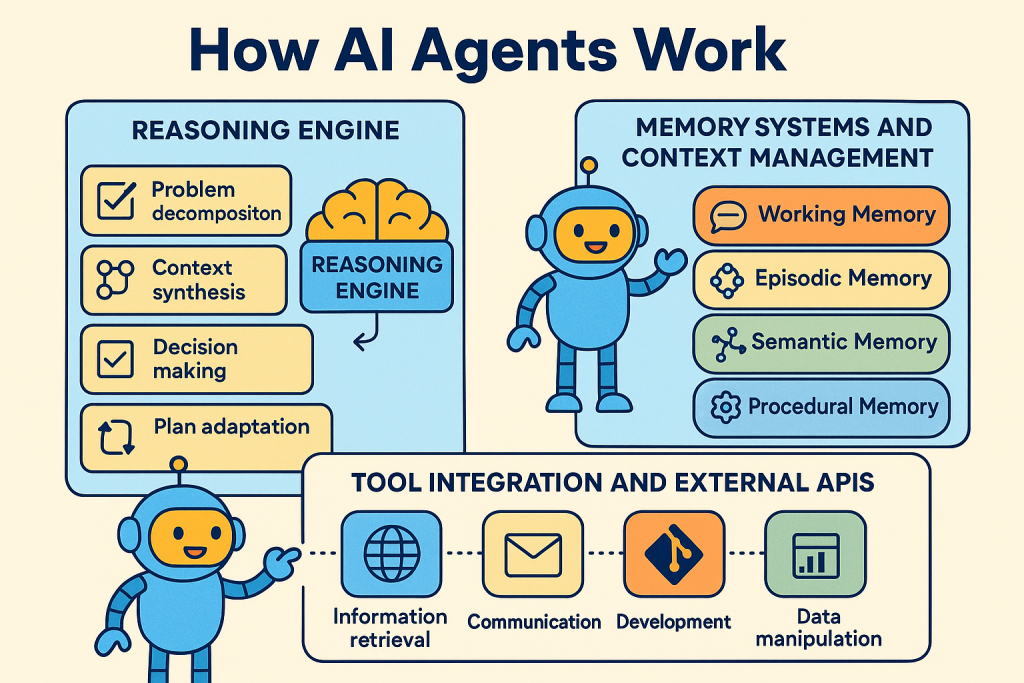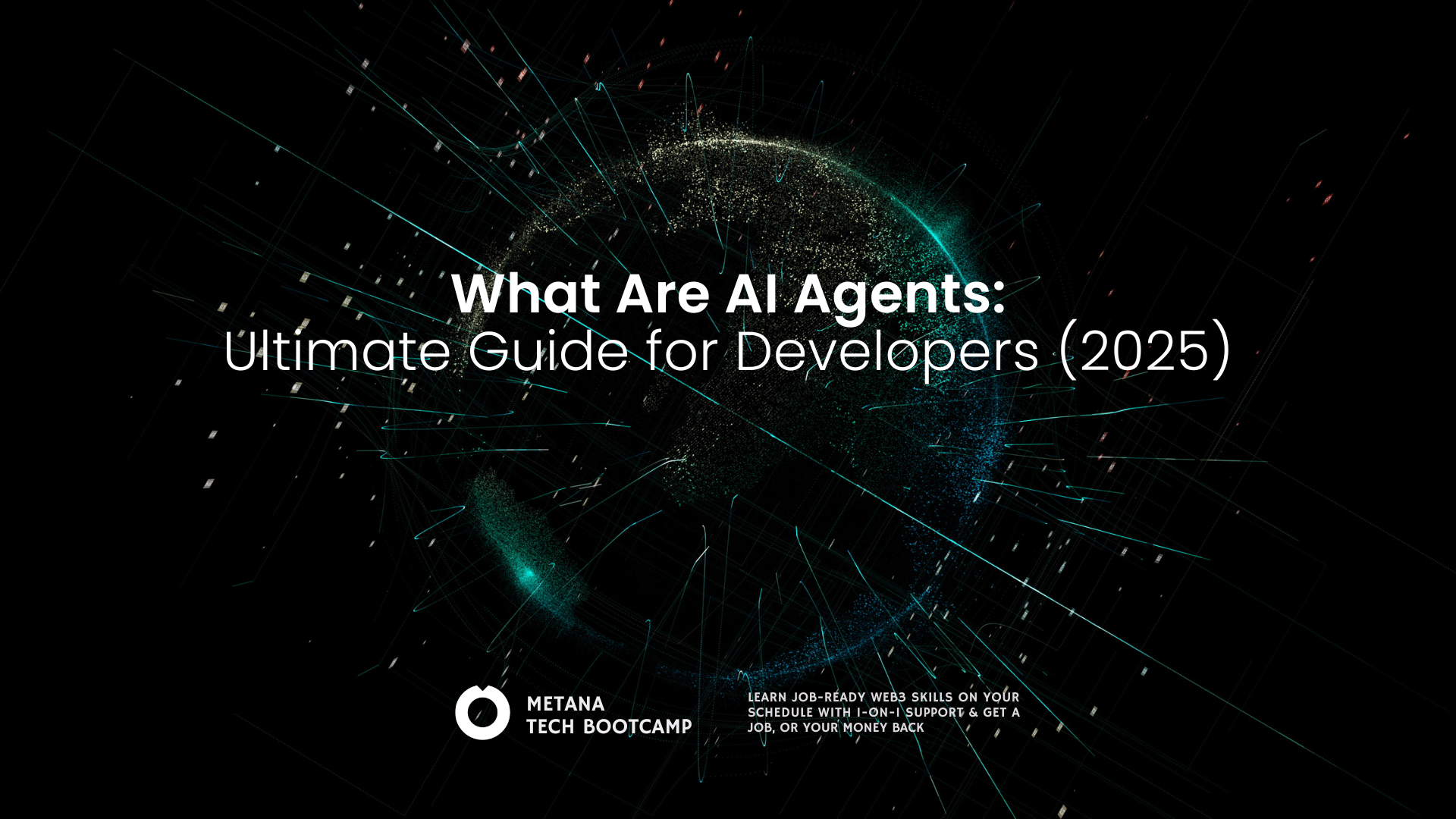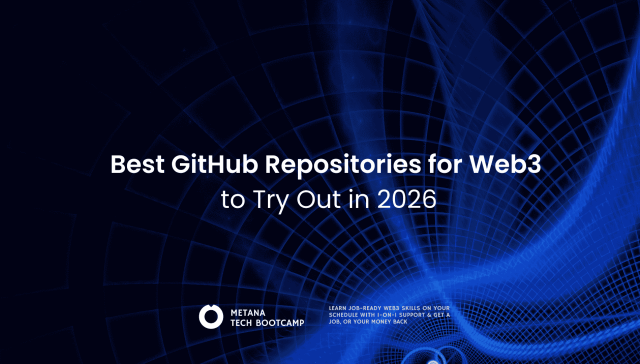AI agents are autonomous software systems that combine reasoning, planning, memory, and action to achieve user goals. Unlike chatbots or assistants, they adapt over time, process multimodal input (text, code, images, audio), and integrate with external tools and APIs to act in the real world.
TL;DR – Quick Takeaways on AI Agents
- AI agents = autonomous, goal-driven software that can perceive, reason, remember, and act in real-world systems.
- Architecture combines a reasoning engine (LLM), memory layers, and tool/API integrations.
- Types include reactive vs proactive, conversational vs task-execution, single-purpose vs multi-agent systems, and surface vs background agents.
- Use cases span customer service, code generation, workflow automation, data analysis, and marketing.
- Web3 unlocks decentralized autonomous agents (DAAs) that interact with smart contracts and token economies.
- Challenges remain — context limits, hallucinations, costs, ethics, and security risks.
- Tools to build agents include LangChain, AutoGPT, CrewAI, and cloud platforms like AWS, Azure, and Google Vertex AI.
- Careers are expanding into roles like Agent Developer, Multi-Agent Architect, and AgentOps Engineer.
- Next step for developers: automate one small task with an agent, learn from it, and scale — the future of software is autonomous and collaborative.
Picture this: You wake up tomorrow and your digital assistant has already analyzed overnight market trends, updated your development environment with the latest security patches, and scheduled your team’s sprint planning around everyone’s optimal productivity hours. It didn’t just follow commands. It reasoned through complex scenarios and made decisions.
That’s not science fiction anymore. That’s the power of AI agents. For developers entering 2025, understanding AI agents isn’t just nice-to-have knowledge—it’s becoming as fundamental as knowing APIs or databases.
While chatbots respond to what you ask, AI agents think ahead. They reason through problems, remember context from weeks ago, and take action without constant hand-holding.
What Are AI Agents? (Beyond Basic Definitions)
Think of traditional software as a vending machine. You put in specific input, press the right button, and get predictable output. AI agents? They’re more like having a competent colleague who understands your goals and figures out how to achieve them.
AI agents are software systems that use AI to pursue goals and complete tasks on behalf of users. They show reasoning, planning, and memory and have a level of autonomy to make decisions, learn, and adapt. But that definition barely scratches the surface of what you can build with them.
The magic happens in three core areas: perception (understanding complex inputs), reasoning (making logical decisions), and action (executing tasks in the real world). Unlike static programs that follow predetermined paths, agents adapt their behavior based on changing conditions and new information.
Key Components That Make an Agent “Intelligent”
| Component | Role | Example |
|---|---|---|
| Reasoning Engine | The “brain” that breaks down problems & makes decisions | GPT-4/Claude analyzing a coding issue |
| Memory | Stores context across time (working, episodic, semantic, procedural) | Remembering your past project bugs |
| Tool Integration | Connects to APIs & services to act | Running Git commands, sending Slack alerts |
| Planning System | Chooses optimal path toward a goal | Optimizing deployment strategy |
What is the difference between AI Agents, AI Assistants, and Bots?
Traditional software follows the “if this, then that” model. AI agents operate on “given this context and these goals, what’s the best approach?” They’re less like following a recipe and more like having cooking intuition.
Consider code review processes. Traditional tools flag syntax errors and style violations. An AI agent might notice that your recent commits show a pattern of race condition bugs, suggest adding specific testing frameworks, and automatically set up monitoring for similar issues in production.
This shift from reactive to proactive behavior changes everything about how we build and interact with software systems.
| Difference | AI Agent | AI Assistant | Bot |
|---|---|---|---|
| Purpose | Operates autonomously to achieve goals, often across multiple steps and tools | Helps users complete tasks by understanding natural language and guiding them step by step | Automates predefined tasks or simple conversations based on rules |
| Capabilities | Can plan, reason, learn, adapt, and make decisions independently; executes complex workflows | Provides information, recommendations, and actions in response to user input; relies on user supervision for final decisions | Limited to scripted commands, menus, or triggers; little to no reasoning or adaptability |
| Interaction | Proactive and goal-driven — may take initiative without waiting for user prompts | Reactive but collaborative — interacts with users in natural language, guiding them through tasks | Reactive only — responds to specific inputs with predefined outputs |
| Autonomy | High – can work independently, chain tools, and optimize workflows | Medium – supports the user but doesn’t act fully independently | Low – follows rules, cannot adapt beyond its programmed scope |
| Complexity | Best for dynamic, multi-step problems like workflow automation, multi-agent collaboration, or autonomous research | Ideal for day-to-day productivity tasks like scheduling, answering queries, or customer support | Suited for repetitive tasks like FAQs, notifications, or scripted interactions |
| Learning | Continuously improves with machine learning and memory systems | May include some adaptive learning but still relies heavily on user direction | Typically rule-based, with little or no learning ability |
Key Differences in Plain Terms
- AI Agents are like independent problem-solvers — they don’t just answer but decide, act, and adapt.
- AI Assistants are more like collaborators — they help you complete tasks but usually wait for your direction.
- Bots are rule-followers — fast and efficient at repetitive tasks but without intelligence or adaptability.
How Do AI Agents Work?

Understanding AI agent architecture is like learning how a car engine works—you don’t need to be a mechanic, but knowing the basics helps you drive better and troubleshoot problems.
The Reasoning Engine (Brain of the Agent)
At the heart of every agent sits a reasoning engine, typically powered by a large language model (LLM) like GPT-4, Claude, or specialized models. But here’s the crucial part: the LLM isn’t the agent itself. It’s the processing unit that enables reasoning.
The reasoning engine handles:
- Problem decomposition: Breaking complex tasks into manageable steps
- Context synthesis: Combining information from multiple sources to form coherent understanding
- Decision making: Choosing between multiple possible actions based on current conditions
- Plan adaptation: Modifying strategies when circumstances change
Think of it like having an extremely knowledgeable consultant who never gets tired, never forgets details, and can process vast amounts of information instantly.
Memory Systems and Context Management
Memory is what transforms a smart chatbot into a truly useful agent. Effective agents implement several types of memory:
Working Memory: Immediate context from current session or task. This includes conversation history, current goals, and active variables.
Episodic Memory: Records of past interactions and their outcomes. Your coding agent might remember that last month’s performance optimization involved database indexing, influencing similar future recommendations.
Semantic Memory: General knowledge and learned patterns. This includes programming best practices, common debugging strategies, and domain-specific expertise.
Procedural Memory: Step-by-step knowledge of how to accomplish tasks. Once an agent learns your deployment process, it can replicate and optimize it.
Tool Integration and External APIs
The real power of AI agents comes from their ability to interact with external systems. Think of tools as an agent’s hands and eyes in the digital world.
Common tool categories include:
- Information retrieval: Web search, database queries, documentation lookup
- Communication: Email, Slack, issue tracking systems
- Development: Git operations, CI/CD pipeline management, testing frameworks
- Data manipulation: File operations, data processing, visualization generation
Not all agents are created equal. Understanding different types helps you choose the right approach for specific problems and architect systems that actually work.
Types of AI Agents Every Developer Should Know
Not all agents are created equal. Developers should understand the major categories to pick the right type for specific problems and architect systems that actually work.
1. Based on Behavior: Reactive vs. Proactive
- Reactive Agents
- Respond only to immediate inputs or stimuli.
- Best for support, debugging, or query-based interactions.
- Example: Debugging bot that analyzes a single error message.
- Proactive Agents
- Anticipate needs and take initiative.
- Monitor trends, optimize processes, and act before issues arise.
- Example: Performance-monitoring agent that detects bottlenecks and suggests fixes.
Most production systems mix both — reactive for on-demand tasks, proactive for ongoing optimization.
2. Based on Interaction Style: Conversational vs. Task-Execution
- Conversational Agents
- Focus on dialogue and interactive problem-solving.
- Excellent for brainstorming, tutoring, or pair programming.
- Key Need: Natural conversation design and context management.
- Task-Execution Agents
- Focus on accomplishing a defined task with minimal input.
- Ideal for automation workflows like CI/CD, testing, or data pipelines.
- Key Need: Error handling, transparency, and progress reporting.
3. Based on Scope: Single-Purpose vs. Multi-Agent Systems
- Single-Purpose Agents
- Specialized in one domain (e.g., code optimization, security scanning).
- Easier to design, test, and maintain.
- Best starting point for new developers.
- Multi-Agent Systems
- Teams of specialized agents collaborating or dividing tasks.
- Require orchestration, communication protocols, and conflict resolution.
- Example:
- Agent A → monitors UI performance
- Agent B → manages database optimization
- Coordinator Agent → synchronizes both tasks
Real-World AI Agent Applications (With Examples)
Let’s move from theory to practice. Here’s how AI agents are already transforming different industries and what you can learn from successful implementations.
Customer Service and Support Automation
Modern customer service agents go far beyond scripted chatbots. They understand context, access customer history, and resolve complex issues autonomously.
Example: A telecommunications company’s agent can analyze service outages, check customer account status, process refunds, and escalate complex issues to human specialists—all while maintaining conversation context and customer satisfaction metrics.
Technical Implementation: These agents typically integrate with CRM systems, knowledge bases, billing platforms, and escalation management tools. They use natural language understanding to interpret customer intent and decision trees to determine appropriate actions.
Code Generation and Development Assistance
Development agents are becoming indispensable coding partners. They don’t just generate code—they understand project context, follow established patterns, and adapt to your team’s standards.
Example: GitHub Copilot and similar tools analyze your codebase, understand project requirements, and generate contextually appropriate code suggestions. Advanced implementations can refactor entire modules, write comprehensive tests, and optimize performance bottlenecks.
Technical Implementation: These agents process large codebases, understand programming language semantics, integrate with development environments, and access documentation repositories to provide relevant assistance.
Data Analysis and Business Intelligence
Data analysis agents transform raw information into actionable insights without requiring manual report generation or dashboard configuration.
Example: A marketing agent might analyze campaign performance across multiple channels, identify underperforming segments, research competitor strategies, and generate optimization recommendations—complete with projected ROI calculations.
Technical Implementation: Integration with databases, analytics platforms, visualization tools, and business intelligence systems enables comprehensive data processing and insight generation.
Content Creation and Marketing Automation
Content agents create personalized, brand-consistent materials across multiple formats and channels while maintaining quality and relevance standards.
Example: An e-commerce agent can generate product descriptions, optimize for SEO, create social media posts, and adapt messaging for different customer segments—all while maintaining brand voice and compliance requirements.
How to Build Your First AI Agent
Ready to build something real? Let’s walk through creating a practical AI agent that can actually solve problems for you or your team.
Choosing the Right Foundation Model
Your foundation model choice determines your agent’s capabilities, costs, and performance characteristics. Here’s how to decide:
For Experimentation: Start with OpenAI’s GPT models or Anthropic’s Claude. They’re well-documented, have excellent APIs, and handle most development tasks effectively.
For Production: Consider factors like latency requirements, cost per operation, privacy needs, and specific capability requirements. Google’s Gemini models excel at code analysis, while specialized models might be better for domain-specific tasks.
For Privacy-Sensitive Applications: Look into locally-deployable models like Llama 2 or Code Llama. They require more setup but give you complete control over data processing.
Setting Up the Agent Framework
The framework you choose shapes your development experience and agent capabilities. Popular options include:
LangChain: Comprehensive toolkit with extensive integrations and active community. Great for rapid prototyping and complex agent workflows.
AutoGPT: Focused on autonomous task execution with minimal human intervention. Ideal for building agents that work independently.
Custom Frameworks: Building from scratch gives maximum control but requires more development time. Consider this for specialized requirements or performance optimization.
Here’s a basic agent structure to get you started:
# Basic agent structure example
class DevelopmentAgent:
def __init__(self, model, tools):
self.model = model
self.tools = tools
self.memory = ConversationMemory()
def process_request(self, request):
# Analyze request and determine approach
plan = self.create_plan(request)
# Execute plan using available tools
result = self.execute_plan(plan)
# Learn from experience
self.memory.store_interaction(request, result)
return result
Implementing Core Agent Capabilities
Focus on these essential capabilities for your first agent:
Request Understanding: Parse user input to extract intent, context, and specific requirements. Natural language processing helps, but structured inputs can simplify initial development.
Tool Selection: Implement logic for choosing appropriate tools based on task requirements. Start with simple rule-based selection before adding more sophisticated decision-making.
Error Handling: Agents encounter unexpected situations frequently. Build robust error recovery mechanisms and fallback strategies from the beginning.
Progress Tracking: Long-running tasks benefit from progress updates and intermediate results. Users need visibility into agent activities.
Testing and Deployment Strategies
Testing AI agents requires different approaches than traditional software testing:
Unit Testing: Test individual functions and tool integrations with known inputs and expected outputs.
Integration Testing: Verify that different agent components work together correctly and handle data flow appropriately.
Behavior Testing: Evaluate agent responses to various scenarios, edge cases, and unexpected inputs. This is where human judgment becomes crucial.
Performance Testing: Monitor response times, resource usage, and scalability under realistic workloads.
[PRO TIP: Start with simple, well-defined tasks and gradually increase complexity. It’s easier to debug a focused agent than a general-purpose one.]
AI Agents in Web3 and Blockchain Development
The intersection of AI agents and blockchain technology opens fascinating possibilities for autonomous, trustless systems that could reshape how we think about digital ownership and automated processes.
Decentralized Autonomous Agents (DAAs)
Imagine agents that operate without centralized control, making decisions and executing transactions based on blockchain-verified conditions. These agents could manage investment portfolios, execute complex DeFi strategies, or coordinate supply chain operations—all while maintaining transparent, auditable decision-making processes.
Technical Architecture: DAAs typically combine smart contracts for execution logic with off-chain AI processing for decision making. Oracle networks provide real-world data, while blockchain transactions ensure transparent, immutable action records.
Use Cases: Automated market making, dynamic NFT generation based on market conditions, decentralized content moderation, and autonomous organization management.
For developers trained in blockchain development, this represents a natural evolution—agents that can interact directly with smart contracts and DeFi protocols.
Smart Contract Integration Possibilities
AI agents can dramatically simplify smart contract interaction by abstracting away complex transaction details and optimizing gas usage patterns.
Example Implementation: An agent managing a DeFi portfolio might analyze yield farming opportunities, calculate optimal allocation strategies, and execute rebalancing transactions automatically—all while considering gas costs, slippage, and risk parameters.
Technical Considerations: Agents need secure key management, transaction simulation capabilities, and robust error handling for blockchain interactions. Failed transactions cost gas but provide no value.
Token-Driven Agent Economies
Blockchain enables new economic models where agents can own resources, make payments, and participate in markets autonomously. Token incentives align agent behavior with user goals and network health.
Emerging Models: Agents earning tokens for successful task completion, reputation systems based on blockchain-verified performance history, and markets where agents compete for user attention and resources.
This connects directly to the future of decentralized AI, where agents operate in trustless environments without centralized oversight.
Current Limitations and Challenges
Understanding limitations helps you build more reliable systems and set appropriate expectations for agent capabilities.
Technical Limitations Developers Face
Context Window Constraints: Even advanced models have limits on how much information they can process simultaneously. Long conversations or complex documents may exceed these boundaries.
Hallucination and Accuracy Issues: Agents can generate plausible-sounding but incorrect information, especially for recent events or specialized domains. Always implement verification mechanisms for critical operations.
Computational Costs: Advanced reasoning requires significant processing power. Production agents need careful resource management and cost optimization strategies.
Latency Considerations: Real-time applications may struggle with the processing delays inherent in current AI models. Plan for asynchronous operations and progress indicators.
Ethical Considerations and Bias Issues
AI agents inherit biases from their training data and can amplify harmful stereotypes or make unfair decisions. This is particularly concerning for agents handling hiring processes, financial decisions, or content moderation.
Mitigation Strategies: Implement diverse testing scenarios, regular bias audits, and human oversight for high-stakes decisions. Transparency in decision-making processes helps identify and address problematic patterns.
Security and Trust Concerns
Agents with significant autonomy can become attractive targets for malicious attacks or unintended exploitation.
Common Vulnerabilities: Prompt injection attacks, unauthorized access to integrated systems, and agents being tricked into performing harmful actions.
Security Best Practices: Implement proper input validation, limit agent permissions to minimum necessary levels, and maintain audit logs of all agent actions.
Tools and Platforms for AI Agent Development
Choosing the right development stack significantly impacts your agent’s capabilities and your development experience.
Popular Frameworks and Libraries
LangChain: The most comprehensive agent development framework, offering extensive tool integrations, memory management, and pre-built agent types. Excellent documentation and active community support make it beginner-friendly.
AutoGen: Microsoft’s framework focused on multi-agent conversations and collaborative problem-solving. Great for building systems where multiple agents work together.
Crew AI: Specializes in role-based agent teams with clear hierarchies and collaboration patterns. Ideal for complex workflows requiring multiple specialized agents.
Haystack: Strong focus on document processing and information retrieval agents. Perfect for building knowledge-based systems.
Cloud Platforms and Services
Google Cloud: Vertex AI Agent Builder provides managed infrastructure for agent development and deployment. Integration with Google’s ecosystem simplifies data access and processing.
Microsoft Azure: Azure AI services offer comprehensive agent development tools with strong integration into Microsoft’s productivity suite.
Amazon Web Services: Bedrock provides access to various foundation models, while Lambda functions enable cost-effective agent hosting.
OpenAI: Direct API access to GPT models with assistant capabilities and function calling features built-in.
Open Source vs. Proprietary Solutions
Open Source Advantages: Full control over agent behavior, no vendor lock-in, ability to modify and optimize for specific use cases, and transparent operation logic.
Proprietary Advantages: Professional support, managed infrastructure, regular updates and improvements, and often better performance optimization.
Most successful agent projects combine both approaches—proprietary models for core reasoning capabilities with open-source frameworks for application logic and integrations.
Career Opportunities in AI Agent Development
The AI agent field is creating entirely new job categories while transforming existing roles. Understanding these opportunities helps you position yourself for career growth.
Emerging Job Roles and Skills Required
AI Agent Developer: Combines traditional software development with AI/ML knowledge and system design skills. Focuses on building, testing, and maintaining agent systems.
Agent Experience Designer: Creates intuitive interfaces and interaction patterns for human-agent collaboration. Requires UX design skills plus understanding of AI capabilities and limitations.
Multi-Agent Systems Architect: Designs complex systems where multiple agents collaborate to solve problems. Needs deep technical knowledge plus system thinking and coordination skills.
Agent Operations Engineer: Manages deployment, monitoring, and optimization of production agent systems. Similar to DevOps but specialized for AI systems.
The Road Ahead: Your Next Steps in Agent Development
AI agents are the next big shift in software — autonomous, adaptive, and collaborative. Start small by automating one routine task, learn from it, and scale up. The developers who experiment today will be the ones defining how humans and machines work together tomorrow.
Want to dive deeper into the intersection of AI and blockchain technology? Explore our comprehensive guide on blockchain and AI integration or learn about the emerging field of decentralized AI systems that’s reshaping how we think about autonomous agents.

What are AI agents?
AI agents are intelligent software programs that perceive information, reason about it, and take autonomous actions to achieve goals, adapting to context and integrating with tools or APIs.
What are the types of AI agents?
The main types of AI agents are reactive vs proactive, conversational vs task-execution, single-purpose vs multi-agent systems, and surface vs background agents.
What are examples of AI agents?
Examples include customer support bots, coding copilots, workflow automation agents, fraud detection systems, and decentralized agents in Web3.
How are AI agents different from chatbots?
Chatbots are reactive conversational agents that respond to queries, while AI agents can be proactive, goal-driven, and capable of independent decision-making with memory and tool use.
Who are the Big 4 AI agents?
The “Big 4” in AI agent development are Google, Microsoft, Amazon, and OpenAI, who lead in building large-scale AI and agent frameworks.
What are the 5 types of AI agents?
In classical AI theory, the five types are simple reflex agents, model-based reflex agents, goal-based agents, utility-based agents, and learning agents.
Is ChatGPT an AI agent?
ChatGPT is a large language model, not an agent by itself, but when connected to memory and tools, it can function as the reasoning core of an AI agent.
Is a chatbot an agent?
Yes, a chatbot is a type of AI agent, usually a reactive conversational one, but it lacks the autonomy and proactive decision-making of advanced AI agents.








